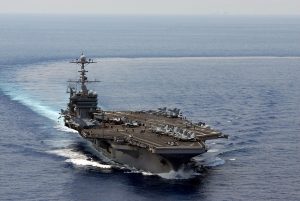It’s not often that I praise Congress or any of its members. But the recent decision by the Senate Armed Services Committee (SASC) to allocate $425 million to maritime security in Southeast Asia puts America’s money where its mouth is on commitments to regional stability and order. Whether this paltry sum (in Pentagon jargon, $425 million would be described as “budget dust”) can make a difference depends on how it’s spent, and how quickly.
Maritime Southeast Asia is ripe with friction among competing disputants, most of whom are incapable of defending their claims with military force—except, of course, for China. As I argued in testimony before the House Committee on Foreign Affairs in February, the region’s fragmented maritime domain allows China to engage in land reclamation and various forms of gray zone coercion largely unchallenged. After spending most of the Cold War focused primarily on internal security, ASEAN militaries are beginning to look outward, reorienting their focus on air and maritime capabilities. But no ASEAN state can mount a meaningful challenge to China alone, and there are currently stark limits on intra-ASEAN maritime cooperation.
This is a growing problem that the U.S. policy of rebalancing to Asia—and an extra $425 million—can actually do something to remedy. Anyone can “arm the locals”; indeed, there’s a regional arms bazaar happening across the Asia-Pacific. But no one other than the United States can offer the mix of resources, organizational capacity, and know-how to responsibly build the capacity of regional partners to cooperate and keep a stable order.
$425 million dispensed over several years, and spread across the likes of Indonesia, Malaysia, the Philippines, Singapore, Thailand, and Vietnam, is certainly a thin investment. It can’t buy fighter upgrades, aircraft carriers, strategic airlift, or military bases and ports. It can’t bring a screeching halt to China’s land reclamation, or immediately change the calculations that lead to China’s next salami-slicing move in the South China Sea.
What it can do, if well invested, is lay the foundations for greater collaboration and interoperability among reluctant Southeast Asian militaries, as well as other extra-regional partners who also have a stake in a peaceful South China Sea.
This can be done in part by creating more opportunities for ASEAN militaries to participate in security cooperation and International Military Education and Training initiatives with the United States. This type of training investment strengthens U.S. defense relationships with regional allies and partners, which is crucial to regional stability; building and sustaining active defense networks with partners is a credible manifestation of an enduring U.S. commitment. It also gives low-capacity ASEAN militaries the chance to integrate their military services with U.S. and coalition networks in multilateral military exercises in which they might not otherwise be able to participate.
Most importantly though, this special fund should be used to fill a glaring operational hole in U.S. Asia strategy: shared situational awareness in the South China Sea. Maritime Southeast Asia needs a common real-time picture for military and commercial ships and aircraft operating in the area, helping manage friction and avoid accidents by allowing everyone to see what assets are positioned where, and what they are doing. Plus, a collective picture is a logical starting point for mobilizing collective action.
Such a common operating picture would aggregate information into a visual display, sourced from participating nations using interoperable software, hardware, and organizational protocols. Joint military exercises help with the latter, and for trusted partners the United States has hardware solutions as well. Software solutions exist in government and the private sector that would even allow individual militaries to operate their own unique hardware and intelligence collection sensors while selectively “pushing” information to the larger group. These solutions and others are part of an ongoing project that I and some of my colleagues at the Center for a New American Security plan to report on later in the year.
Maritime security in the South China Sea is a problem, and the United States is an indispensable part of the solution. $425 million can’t buy anything sexy, but used the right way, it can build a bridge across troubled waters. For once, Congress is reading the region’s trend lines and responding to shape them in a responsible way.

































